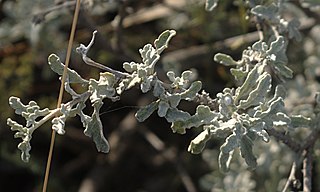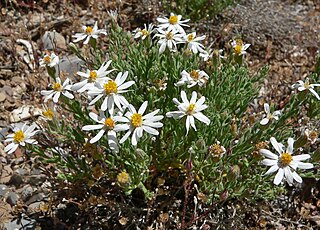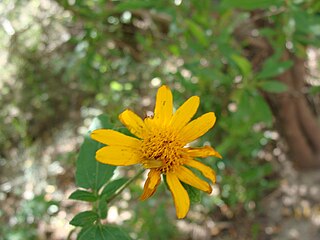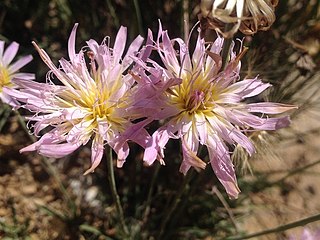
Bahia is a small genus of perennial flowering plants in the family Asteraceae. The common name is also bahia. It is named in honor of the Spanish botanist Juan Francisco Bahí (1775–1841).

Parthenium argentatum, commonly known as the guayule, is a perennial woody shrub in the family Asteraceae that is native to the rangeland area of the Chihuahuan Desert; including the southwestern United States and northern Mexico. It was first documented by J.M. Bigelow in 1852 through the Mexican Boundary Survey and was first described by Asa Gray. Natural rubber, ethanol, non-toxic adhesives, and other specialty chemicals can be extracted from guayule. An alternative source of latex that is hypoallergenic, unlike the normal Hevea rubber, can also be extracted. While Castilla elastica was the most widely used rubber source of Mesoamericans in pre-Columbian times, guayule was also used, though less frequently. The name "guayule" derives from the Nahuatl word ulli/olli, "rubber".

Porophyllum is a genus of flowering plants in the tribe Tageteae within the family Asteraceae known commonly as the poreleaf genus.

Hymenoxys is a genus of plants in the sunflower family, native to North and South America. It was named by Alexandre Henri Gabriel de Cassini in 1828.

Thymophylla is a genus of perennial flowering plants in the tribe Tageteae within the family Asteraceae. Pricklyleaf is a common name for plants in this genus.

Helianthella, the little sunflower, is a genus of North American plants in the family Asteraceae.

Parthenium incanum, with the common names mariola and New Mexico rubber plant, is a plant in the genus Parthenium of the family Asteraceae.

Chaetopappa is a genus of plants in the family Asteraceae which are known generally as leastdaisies.

Psilostrophe, the paperflowers is a genus of North American plants in the sneezeweed tribe within the sunflower family.
Phanerostylis is a genus of Mexican plants in the tribe Eupatorieae within the family Asteraceae.

Zaluzania is a genus of flowering plants in the family Asteraceae.

Sartwellia is a genus of North American flowering plants in the tribe Tageteae within the family Asteraceae. The common name is glowwort. The genus was named for American botanist Henry Parker Sartwell.

Jefea is a genus of North American flowering plants in the family Asteraceae, native to Mexico and the southwestern United States. These are shrubs up to 200 cm tall, with yellow or orange flower heads containing both ray and disc flowers.

Pinaropappus, common name rocklettuce, is a genus of flowering plants in the tribe Cichorieae within the family Asteraceae, native to Mesoamerica and the southwestern United States.

Chrysactinia is a genus of flowering plants in the family Asteraceae, native to Mexico and to the southwestern United States.

Tridens is a genus of perennial grasses in the family Poaceae native to the Americas.
Chondrosum is a genus of North American and South American plants in the grass family.
Ageratina wrightii is a North American species of plants in the family Asteraceae. It is native to the southwestern United States and northern Mexico.
Chaetopappa bellioides, called the pretty lazy daisy, or manyflower leastdaisy, is a North American species of plants in the family Asteraceae. It native to northern Mexico and to the Rio Grande Valley in western and southern Texas.

Chrysactinia mexicana, common name Damianita daisy, is a species of flowering plants in the family Asteraceae, native to Mexico and to the southwestern United States. It has been found in Texas, New Mexico, Aguascalientes, Chihuahua, Coahuila, Durango, Guanajuato, Hidalgo, México State, Nuevo León, Oaxaca, Puebla, Querétaro, San Luis Potosí, Zacatecas, Tamaulipas, and Veracruz.



















